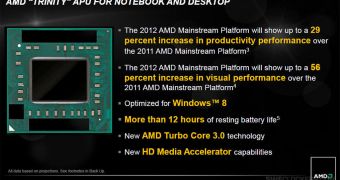Advanced Micro Devices hasn't officially said much about the Trinity series of accelerated processing units, but leaks and reports are doing a great job of satisfying everyone's curiosity.
As if the promising benchmark of the A8-4500M APU weren't already enough to spark people's yearning, we now have a marketing slide to gush over.
Having been provided by the folks at SweClockers, said slide makes some very interesting and bold claims.
Not only is the so-called Trinity series of Accelerated Processing Units (APUs) going to be much faster in terms of graphics, but it will also clearly distance itself in productivity.
To be more specific, the APU will be up to 56% faster when drawing visuals (graphics performance is better by more than half, in other words) while boosting productivity by up to 29%.
The comparisons are drawn between Trinity and Llano (the existing collection of mainstream APUs).
Other than these bold claims, the slide has some other interesting entries and emphasizes the important parts with a nice, golden font (or plain yellow, for those who disavow such epithets).
For one, an honorary mention is given to optimizations for Windows 8, the new operating system that Microsoft will launch this year.
Of course, with AVX, AES-NI, SSE4.2, and DirectX 11.1 graphics integrated into the GPU, this goes without saying.
Secondly, the power efficiency is said to be enough to enable 12 hours of “resting battery life”, whatever that means (basic computing tasks or idle times, probably).
Thirdly, the marketing slide lists the 3.0 version of the Turbo Core dynamic overclocking technology (powers down/up individual cores depending on workload and TDP).
Finally, the media accelerators will possess new features, but no details exist on this front, not that we are surprised.
All in all, Advanced Micro Devices has everything it needs to score consumer and business deals. Now it just needs a silver tongue sly enough to charm prospective customers away from Intel.

 14 DAY TRIAL //
14 DAY TRIAL //